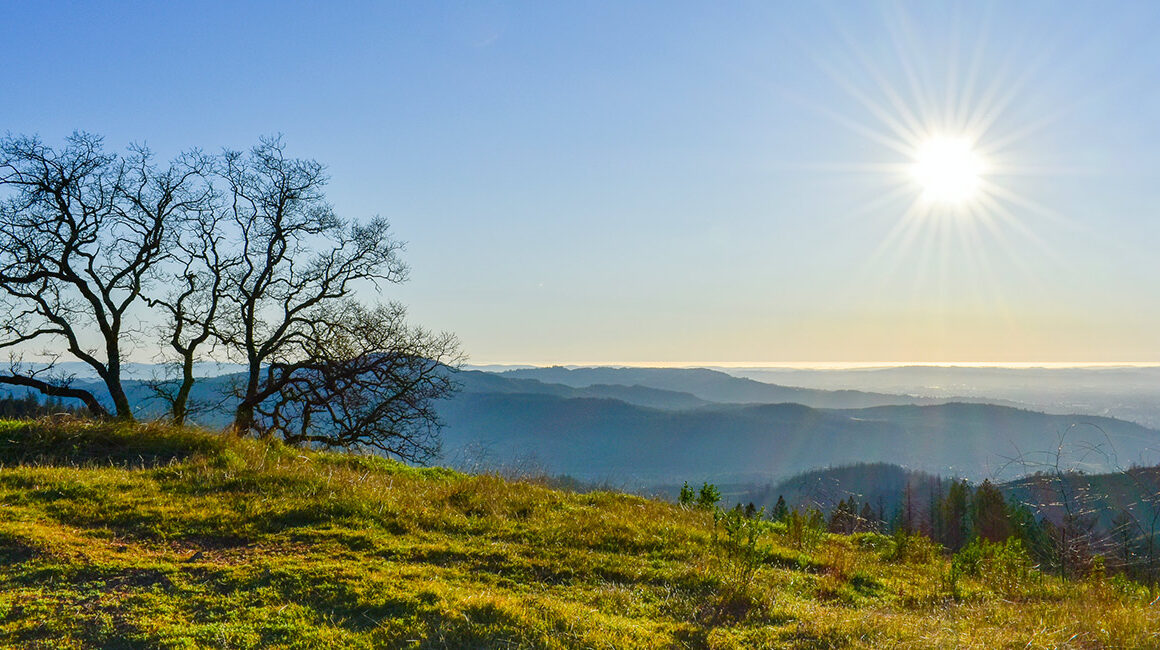Finding Awe in Sonoma County
By Virginie Boone
With fall in its full glory and winter bearing down, this is a wonderful time to remember the many places in Sonoma County that inspire awe with their sheer force of beauty.
The Sonoma County Regional Parks recently put out a list of “Awe Walks,” with Bodega Bay-based naturalist Stephen Nett detailing the power of awe:
“Experts say awe is a response to something so astonishing, beautiful, powerful or vast it exceeds our usual understanding of the world. The feeling is like intense amazement with a slight edge of disorientation or danger. We may get goosebumps or chills. Awe is also powerful enough, psychologists find, that it can actually shift how we view ourselves. And that can be very positive, in a number of ways.”
Nett details a few Sonoma County experiences capable of provoking awe, from climbing the trail up to Gunsight Rock at Hood Mountain Regional Park and Open Space Preserve to take in the views from 2,730 feet, to camping at Hood Mountain’s Merganser Pond to hear hundreds of frogs ribbiting in the dark. Hood Mountain is both Sonoma County’s highest peak in the Mayacamas Mountains and the park with the most extensive trail system within the regional parks system.
“Studies show that when we ‘feel smaller’ with awe,” he continues, “we’re more generous, feel more connected to others, and are more willing to engage…. That leads some to think that awe may have an evolutionary role. By reducing our self-centered perspective, it may have affected how humans get along with each other and cooperate for a greater good.”
Another place to feel awe is Gualala Point Regional Park, at Sonoma County’s northern end, near the border with Mendocino County. A beach and estuary, this is where the river meets the ocean. While the gorgeous ocean views and birdlife are two sources of awe, the park also features the Serge Posts, ceremonial posts created by wood carvers from the Sakha Republic in Russia.
The Sakha first came to Sonoma County to settle Fort Ross in the early 19th century. The posts are made from 40-foot Douglas fir trees and were dedicated on the summer solstice in 2014.
The Laguna de Santa Rosa is one of the largest tributaries of the Russian River, a 254-square-mile freshwater wetlands complex that typically evolves into a marsh during the winter, creating vernal pools for the plants, birds and wildlife to inhabit. Bald eagles, mink, river otters and more thrive in its environment, in addition to the migratory birds who stop here along the Pacific flyway. It also helps to mitigate flooding in other parts of the area, acting as a natural reservoir.
North Sonoma Mountain Regional Park and Open Space Preserve atop Sonoma Mountain Road consists of 820 acres of parkland, including four miles of the Bay Area Ridge Trail that climb to 2,000 feet, connecting it to Jack London State Historic Park. The awesome highlight here this time of year is the heady scent of the bay laurel trees that accent the trail.
Standing beneath groves of redwood and Douglas fir forest will also inspire awe. Monte Rio Redwoods Regional Park and Open Space Preserve offers 515 acres of redwood grove and a welcome escape from reality.
Armstrong Redwoods State Natural Reserve nearby is equally grand, a sanctuary of Sequoia sempervirens, or coast redwood, the tallest living thing on earth. These trees can live to 2,000 years old and stand up to 350 feet tall. They exist from southern Oregon to central California no more than 50 miles inland from the coast, requiring a coastal climate and plenty of fog to survive, in addition to abundant rainfall, allowing them to grow two to three feet a year.
Redwoods flower during the wet and rainy months and produce cones with seeds, sometimes 100,000 seeds a year per tree, though the germination rate is low. Douglas fir is second in size to the coast redwood; both trees are often accompanied by big leaf maple, California bay laurel, tan oak trees as well as California hazel and woodrose, both shrubs, and ferns like the sword fern and bracken fern.
For something completely different, consider a visit to the Running Fence Watson School Historic Park along the Bodega Highway in Bodega Bay. The Watson School was built in 1856 to serve the towns of Bodega, Freestone and Valley Ford and operated until the late 1960s.
Next to it is a tribute to Running Fence, a Christo and Jeanne-Claude art work created between 1972 and 1976 from heavy woven white nylon fabric hung from steel cable that stretched 24.5 miles along the properties of 59 ranchers. Crossing 14 roads and Valley Ford, it left passage for cars, cattle and wildlife. It was taken down 14 days after completion, representing just a short moment in history.
“The primary goal of an awe walk is to focus outside yourself for a time,” Nett concludes. “Leave the daily world behind and be absorbed by what surrounds you.”
Do you have a favorite awe walk? Share it with us.
Image by: Sonoma County Regional Parks


